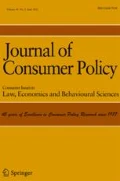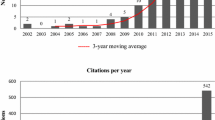Abstract
This article discusses the distribution of widely used consumer loans in Denmark in the light of the “risk position” in which this places Danish households. Denmark has the highest debt-to-income ratio of all OECD countries, yet the high level of consumer debt has received relatively little political attention in Denmark and the social and legal protection of citizens with debt problems is limited. This article presents findings from an empirical study that investigated the distribution of consumer loans in Denmark. Drawing on the notion of “risk position,” the article challenges the idea that only socially marginal groups are at risk of getting into debt problems. The empirical study analysed the sociodemographic distribution of two common types of loan in Denmark (bank loans and credit card debt) based on the administrative register data of a full population of individuals. Register-based data provide much more reliable measures of debt than self-reported surveys, because of non-response problems in surveys. The results show not only high debt levels among hitherto known vulnerable social groups, but also highlight groups of middle- and higher-income wage earners with very high levels of debt. We frame the results in the light of existing policy measures in Denmark and suggest the need for a better balance between deregulation of credit markets and individualization of debt problems on the one hand and the need for political protection of individual loan takers on the other.
Similar content being viewed by others
Notes
We tested a model without removing outliers and it gave a similar result with slightly different estimates.
This relatively tight regulation of data sharing, however, also protects consumers’ personal data and limits the usage of non-credit data in a recently automated scoring process or what Hurley and Adebayo (2017) have called “credit scoring by association.”
References
Adkins, L. (2017). Speculative futures in the time of debt. The Sociological Review, 65(3), 448–462.
Almaas, S., Bystrøm, L., Carlsen, F., & Su, X. (2015). Home equity-based refinancing and household financial difficulties: The case of Norway. SSRN Electronic Journal. Retrievd from SSRN at https://doi.org/10.2139/ssrn.2523025. (accessed 10 April 2021)
Andersen, L. L., Poppe, C., & Böcker Jakobsen, T. (2009). Lånefest? Betydningen af kreditfinansieret forbrug blandt udvalgte grupper i den danske middelklasse (Borrowing like crazy? The significance of credit-financed consumption among selected groups in the Danish middle class). Copenhagen: Thomson Reuters.
Autio, M., Wilska, T.-A., Kaartinen, R., & Lähteenmaa, J. (2009). The use of small instant loans among young adults – A gateway to a consumer insolvency? International Journal of Consumer Studies, 33(4), 407–415.
Balmer, N., Pleasence, P., Buck, A., & Walker, H. C. (2006). Worried sick: The experience of debt problems and their relationship with health, illness and disability. Social Policy and Society, 5(1), 39–51.
Borgeraas, E., Poppe, C., & Lavik, R. (2016). Consuming the home. Walking the thin line between welfare and catastrophe. Italian Sociological Review, 6(1), 87–111.
Caplovitz, D. (1981). Making ends meet: How families cope with inflation and recession. The Annals of the American Academy of Political and Social Science, 456(1), 88–98.
Carlsson, H., Larsson, S., & Åström, F. (2015). Over-indebtedness and consumption patterns in digital society – A research review. Lund University Internet Institute.
Danish Bankers Association. (2007). Lån til forbrug – en undersøgelse af markedet for lån til forbrug (Consumer loans – A market survey on consumer loans). Finansrådet.
Danish Consumer Council. (2015). Ungdomsliv på kredit. Gældsproblemer i forbrugersamfundet (Youth on credit. Debt problems in the consumer society). Forbrugerrådet TÆNK.
Danish Consumer Council. (2018). Økonomisk mistrivsel blandt unge voksne (Financial discomfort among young adults). Forbrugerrådet Tænk.
Danish Ministry of Economic and Business Affairs: Økonomi- og Erhvervsministeriet. (2010) Analyse af markedet for forbrugslån i Danmark (Analysis of the market for consumer loans in Denmark), Copenhagen. Retrieved from https://www.ft.dk/samling/20091/almdel/eru/bilag/299/881368.pdf. (accessed 10 April 2021)
Danish Ministry of Industry, Business and Financial Affairs: Erhvervsministeriet. (2020). Nu er lovgivningen om opgør med kviklån på plads, Retrieved from https://em.dk/nyhedsarkiv/2020/juni/nu-er-regler-om-opgoer-med-kviklaan-paa-plads/ (accessed 5 August 2020).
Deville, J. (2016). Debtor publics: Tracking the participatory politics of consumer credit. Consumption Markets & Culture, 19(1), 38–55.
Epstein, G. A. (2005). Financialization and the world economy. Cheltenham: Edward Elgar Publishing.
Friedline, T., & Kepple, N. (2017). Does community access to alternative financial services relate to individuals’ use of these services? Beyond individual explanations. Journal of Consumer Policy, 40, 51–79.
Hiilamo, H. (2018). Household debt and economic crises: Causes, consequences and remedies. Cheltenham: Edward Elgar Publishing.
Hiilamo, H., & Kangas, O. (2013). Recipe for a better life: Experiences from Nordic countries. Crisis Management Initiative.
Hohnen, P. (2020). Debt is what happens, while… The emerging field of digital finance and precaritization in everyday lives of young Danes. In A. Sen, J. Lindquist, & M. Kolling (Eds.), Who’s cashing in? Contemporary perspectives on new monies and global cashlessness (pp. 32–45). New York, NY: Berghahn Books.
Hohnen, P., & Böcker Jakobsen, T. (2015). Forbrug og Gæld (Consumption and debt). In B. Greve, A. Jørgensen, & J. Elm Larsen (Eds.), Det Danske Samfund (Danish society) (pp. 413–447). Copenhagen: Hans Reizels Forlag.
Hohnen, P., Gram, M., & Böcker Jakobsen, T. (2020). Debt as the new credit or credit as the new debt? A cultural analysis of credit consumption among Danish young adults. Journal of Youth Studies, 23(3), 356–370.
Hurley, M., & Adebayo, J. (2017). Credit scoring in the era of big data. Yale Journal of Law and Technology, 18(1), 148–216.
Jørgensen, T. (2012). Gældsrådgivning i Danmark og Norge (Advice on debt in Denmark). In H. Juul, F. Meding, & P. Shaumburg-Müller (Eds.), Vennebog til Lennart Lynge Andersen (pp. 181–202). Copenhagen: Karnov.
Jørgensen, T. (2014). The way to over-indebtedness – Intensive marketing, easy access to loans, and insufficient legislation (Denmark). Juridica International, 22, 71–95.
Jørgensen, T. (2015). Hurtiglån: Mål og Middel (Quick loans: Why and how). Erhvervsjuridisk Tidsskrift, 2, 111–121.
Kempson, E., & Collard, S. (2005). Affordable credit. The way forward. Bristol: Policy Press.
Langley, P. (2008). Sub-prime mortgage lending: A cultural economy. Economy and Society, 37(4), 469–494.
Langley, P. (2014). Consuming credit. Consumption, Markets and Culture, 17(5), 417–428.
Lauer, J. (2017). Creditworthy: A history of consumer surveillance and financial identity in America. New York, NY: Columbia University Press.
Lazzarato, M. (2012). The making of the indebted man: An essay on the neoliberal conditions (J. D. Jordan, trans.). Lose Angeles, CA: Semiotext(e).
Majamaa, K., Lehtinen, A.-R., & Rantala, K. (2019). Debt judgments as a reflection of consumption-related debt problems. Journal of Consumer Policy, 42, 223–244.
Marron, D. (2012). Producing over-indebtedness. Journal of Cultural Economy, 5(4), 407–421.
Marron, D. (2014). Informed, educated and more confident: Financial capability and the problematization of personal finance consumption. Consumption, Markets and Culture, 17(5), 491–511.
Martin, R. (2002). Financialization of daily life. Philadelphia, PA: Temple University Press.
Maurer, B. (2014). Postscript: Is there money in credit? Consumption Markets & Culture, 17(5), 512–518.
OECD. (2019). Household debt (indicator). Retrieved from https://doi.org/10.1787/f03b6469-en (accessed 10 April 2021).
Oksanen, A., Aaltonen, M., & Rantala, K. (2015). Social determinants of debt problems in a Nordic welfare state: A Finnish register-based study. Journal of Consumer Policy, 38(3), 229–246.
Patel, A., Balmer, N. J., & Pleasence, P. (2012). Debt and disadvantage: The experience of unmanageable debt and financial difficulty in England and Wales. International Journal of Consumer Studies, 36(5), 556–565.
Pellandini-Simanyi, L., & Vargha, Z. (2020). How risky debt became ordinary: A practice theoretical approach. Journal of Consumer Culture, 20(2), 235–254.
Peñaloza, L., & Barnhart, M. (2011). Living U.S. capitalism: The normalization of credit/debt. Journal of Consumer Research, 38(4), 743–762.
Poddar, A., Ellis, C. M., & Ozcan, T. (2015). Imperfect recall: The impact of composite spending. Information disclosure on credit card spending. Journal of Consumer Policy, 38(1), 93–104.
Poppe, C. (2008). Into the debt quagmire. How defaulters cope with severe debt problems (Doctoral Dissertation, University of Oslo, Norway). Retrieved from http://urn.nb.no/URN:NBN:no-19723 (accessed 10 April 2021).
Poppe, C., Lavik, R., & Borgeraas, E. (2016). The dangers of borrowing in the age of financialization. Acta Sociologica, 59(1), 19–33.
Raijas, A., Lehtinen, A.-R., & Leskinen, J. (2010). Over-indebtedness in the Finnish consumer society. Journal of Consumer Policy, 33, 209–223.
Sjørslev, I. (2012). ‘Cash the Equity and Realize Yourself’: An anthropological approach to house values. Housing Theory and Society, 29(4), 382–400.
Soederberg, S. (2013). The US debtfare state and the credit card industry: Forging spaces of dispossession. Antipode, 45(2), 493–512.
Statistics Denmark. (2019). Forbrugerkredit. Retrieved from https://www.dst.dk/da/Statistik/emner/penge-og-kapitalmarked/andre-finansielle-formidlere/forbrugerkredit (accessed 10 April 2021).
Swedish Enforcement Authority: Kronofogeden. (2008). Alla vill göra rätt för sig. Överskuldsättningens orsaker och konsekvenser (Everyone wants to do the right thing. The causes and consequences of over-indebtedness). Can be downloaded from docplayer.se
van der Zwan, N. (2014). Making sense of financialization. Socio-Economic Review, 12(1), 99–129.
Wooldridge, J. M. (2010). Econometric analysis of cross section and panel data (2nd ed.). Cambridge, MA: MIT Press.
Author information
Authors and Affiliations
Corresponding author
Additional information
Publisher’s Note
Springer Nature remains neutral with regard to jurisdictional claims in published maps and institutional affiliations.
Rights and permissions
About this article
Cite this article
Hohnen, P., Hansen, A.R. Credit Consumption and Financial Risk Among Danish Households— A Register-Based Study of the Distribution of Bank and Credit Card Debt. J Consum Policy 44, 311–328 (2021). https://doi.org/10.1007/s10603-021-09485-1
Received:
Accepted:
Published:
Issue Date:
DOI: https://doi.org/10.1007/s10603-021-09485-1




